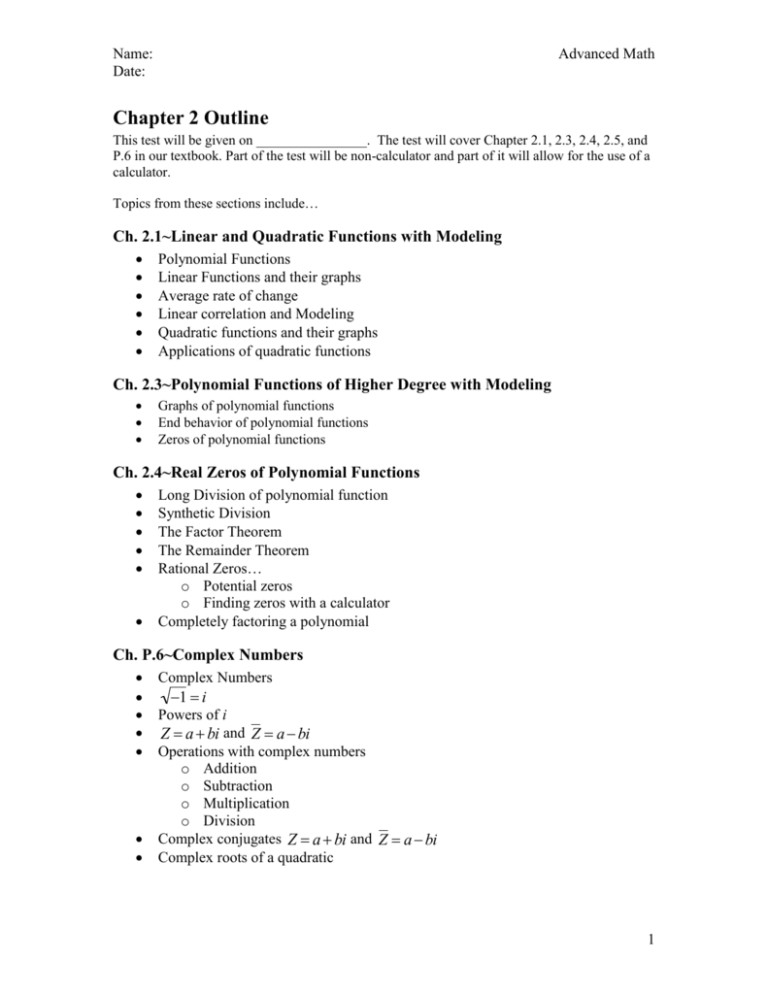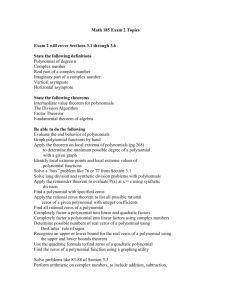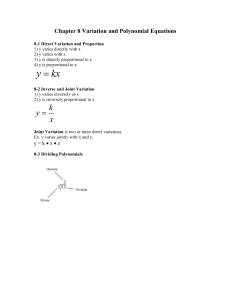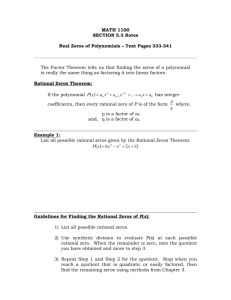Chapter 2 Outline
advertisement

Name: Date: Advanced Math Chapter 2 Outline This test will be given on ________________. The test will cover Chapter 2.1, 2.3, 2.4, 2.5, and P.6 in our textbook. Part of the test will be non-calculator and part of it will allow for the use of a calculator. Topics from these sections include… Ch. 2.1~Linear and Quadratic Functions with Modeling Polynomial Functions Linear Functions and their graphs Average rate of change Linear correlation and Modeling Quadratic functions and their graphs Applications of quadratic functions Ch. 2.3~Polynomial Functions of Higher Degree with Modeling Graphs of polynomial functions End behavior of polynomial functions Zeros of polynomial functions Ch. 2.4~Real Zeros of Polynomial Functions Long Division of polynomial function Synthetic Division The Factor Theorem The Remainder Theorem Rational Zeros… o Potential zeros o Finding zeros with a calculator Completely factoring a polynomial Ch. P.6~Complex Numbers Complex Numbers -1 = i Powers of i Z = a + bi and Z = a - bi Operations with complex numbers o Addition o Subtraction o Multiplication o Division Complex conjugates Z = a + bi and Z = a - bi Complex roots of a quadratic 1 Name: Date: Advanced Math Ch. 2.5~Complex Zeros and The Fundamental Theorem of Algebra The Fundamental Theorem of Algebra Linear Factorization Theorem Complex conjugate zeros Finding a polynomial from given zeros Factoring a polynomial with complex zeros Finding complex zeros Factoring with real number coefficients o Factoring a polynomial…also know that odd degree polynomials have at least one real zero. 2 Name: Date: Advanced Math Chapter 2 - Practice Problems Please note: These problems are collected from previous tests and quizzes on this material 1. Use Long Division to divide f(x) by d(x) and write an answer in polynomial form. f(x) = 5x4 + 14x3 + 9x ;d(x) = x2 + 3x 2. Use long division to find the quotient and remainder when dividing -2x 3 + 5x 2 - 6x + 5 by 2x-1 3. Use the factor theorem to determine which of the following are factors of f ( x) = 3x 4 -17x 3 - 27x 2 +173x + 60 x+2, x-3, x+4, x-5 4. Use the remainder theorem to find the remainder when f(x) is divided by x – k. Check your answer by using synthetic division. f(x) = 3x3 - 2x2 + x – 5 ;k = -2 5. Use the rational zero theorem to come up with a list of potential rational zeros. Then determine which ones, if any are zeros. f(x) = 2x4 - x3 - 4x2 - x – 6 6. Find all of the real zeros of the function, finding exact values whenever possible. Identify each zero as rational or irrational. f(x) = x4- x3- 7x2 + 5x + 10 7. Use long division to find the quotient and remainder when (4x 3 + 8x 2 - 9x -18) ¸ ( x + 2) 8. Use synthetic division to find the quotient and remainder when (3x 9. 3 -16x 2 - 72) ¸ ( x + 4) ( ) Find the remainder of x 3 - 3x 2 + 5 ¸ ( x + 3) without doing long or synthetic division. 3 Name: Date: 10. Advanced Math Use the factor theorem to determine which of the following are factors of x 3 - 5x 2 + 3x + 9. Work must be shown to justify your answer a) x -1 b) x + 3 c) x - 3 11. Find the remaining zeros of x3 – 8x2 + 9x + 6 if x = 2 is itself a zero. In problems 12-16 perform the indicated operation (without using a calculator) and write the result in a + bi form. 12. (-5 + 7i) + (14 + 3i) 13. (-3 + 2i)( 4 - i) 14. 1+ 3i 5 - 2i 15. i 33 + i15 16. i 23 - i 18 i 57 17. If z = -3-5i, then find 18. If z = 5-12i, the find z · z 19. Solve for x and y to make the equation true. z·z (3 – 2i) – 8 = x – (-7 + yi) 20. Simplify (i 29 ) 71 4 Name: Date: Advanced Math -12 and then -3 ( -12 )( -3) 21. Simplify 22. I should have used pencil! Your pen just exploded all over the graph in figure below. You remember y that the function is 2x 3 - 5x 2 - 4x + 3. Use what’s visible below and synthetic division to help you come up with a completely factored 4 polynomial. –3 –2 –1 1 2 3 x –4 f (x ) = 2 x 3 - 5x 2 - 4 x + 3 5 Name: Date: Advanced Math 23. The graph and some additional information about a polynomial P(x) are presented below. • P(x) is a degree 5 polynomial with real coefficients. • The graph of P(x) for real numbers x is given on the grid. The only x-intercepts of P are at x = 4 and x = –3. • In the complex numbers, P(i+1) = 0. Find the polynomial P(x) Your final answer should be expressed as linear and irreducible quadratic factors with real coefficients. 24. a. Find all solutions of the equation b. Finding the solutions of the equation cube roots of what number? . is equivalent to finding the three 6 Name: Date: Advanced Math 25. You are given this information about a polynomial Q(x): Q(x) is a degree 5 polynomial with real coefficients. The graph of Q(x) for real numbers x is given on the grid. Its only x-intercepts are at x = –2 and x = 0. Q(–1) = 4. In the complex number system, Q(1 – 2i) = 0. Find the factorization of Q(x) in the real number system. 26. Write a polynomial function in standard form (meaning it has real coefficients) whose degree is 3 and has zeros at 2 and 1 + i. 7 Name: Date: Advanced Math Practice Problems Solutions 1. Quotient: 5x 2 - x + 3, remainder: 0 2. Quotient: -x 2 + 2x - 2, remainder: 3 3. x-5 4. -39 1 3 5. ±1,± ,±2,±3,± ,±6 2 2 6. x = -1 rational x = 2 rational x = 5 irrational 7. Quotient: 4x 2 - 9, remainder: 0 8. Quotient: 3x 2 - 28x +112, remainder: -520 9. -49 10. x -3 x 2, x 3 2 3 11. 12. 9 + 10i 13. -10 + 11i -1+ 17i 14. 29 15. 0 16. -1-i 17. 34 18. 169 19. x = -12 and y = 2 20. -i 21. 2, and -6 22. ( x +1)(2x -1)( x - 3) 1 2 23. P( x ) = - ( x + 3) ( x - 4 ) x 2 - 2x + 2 36 3 3i 3 x , x 3 24a. 2 24b. -27 1 2 25. Q( x ) = - x ( x + 2) x 2 - 2x + 5 2 3 2 26. x - 4x + 6x - 4 ( ( ) ) 8









